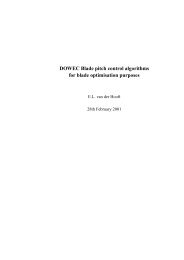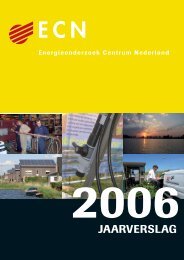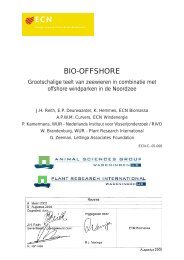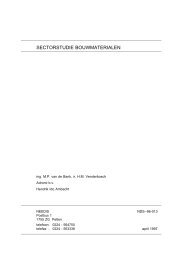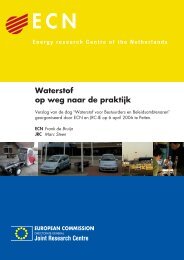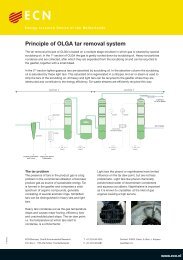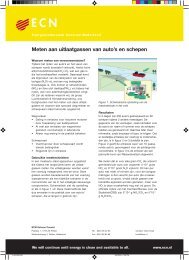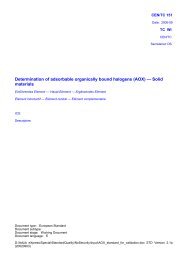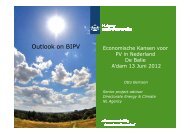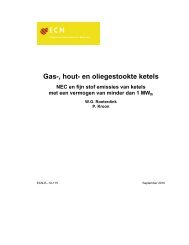PDF format (503 kB) - ECN
PDF format (503 kB) - ECN
PDF format (503 kB) - ECN
You also want an ePaper? Increase the reach of your titles
YUMPU automatically turns print PDFs into web optimized ePapers that Google loves.
very large market share in Europe. Still, glass has a large market share in the packaging used in Europe. About<br />
23% of the packaging materials is glass which corresponds to 17250 ktonne in 1994 [APME, 1996]. In 1995<br />
54% of glass packaging in Europe was collected for recycling [Anon. 1996].<br />
For the MARKAL- model we will define 2 glass bottles (large and small) and 1 jar. The large bottle is defined<br />
as a bottle with a volume of 1 liter while the small bottle has a volume of 0.3 liter. The jar has a volume of 0.5<br />
liter (in between the often used standards of 72 and 37 centiliter). Based on SVM (1993a) we estimate the<br />
weight of these bottles and jars at 500, 250 and 250 grams respectively.<br />
The glass bottles can be improved in order to reduce the amount of packaging waste. In the Netherlands many<br />
projects have taken place to reduce the weight of glass bottles. The weight of milk bottles was reduced with<br />
33%, the weight of several liquor bottles was reduced with 20% and 22% [SVM, 1994]. It seems possible to<br />
reduce the weight of large glass bottles in Europe with 25% in 2020. Projects have taken place to reduce the<br />
weight of small glass bottles like beer bottles with 5.5% [SVM, 1994]. The glass industry in The Netherlands<br />
expected in 1993 a weight reduction of 15% in 1995 compared to 1991. We will use this figure for the improvement<br />
of the small glass bottle [SVM, 1993]. The weight of mushroom jars was reduced with 20% by a<br />
company in 1994 and in 1992 vegetable jars were reduced in weight with 14%. Furthermore, some jam and<br />
jelly bottles were reduced in weight by 10% in 1995 [SVM, 1992, 1994, 1995].<br />
Besides weight reduction a lot of resources can be saved by glass recycling. Two types of recycling are possible:<br />
product re-use and material recycling. Currently, the European recycling rate is already 50%. The Swiss recycling<br />
rate is the highest in Europe (85%) and can be seen as the absolute maximum for Europe. However, due<br />
to the large transportation distances in Europe in rural area’s this figure is not very likely to be reached. We<br />
assume a maximum recycling rate in Europe of 70%. We furthermore assume that color separation is possible<br />
for all the glass that is collected separately; in the U.K. already 95% of the recycled glass is sorted on color. In<br />
The Netherlands beer bottles and some jar types are recycled with a deposit system (product recycling). We assume<br />
that this system is also an option for Europe after 2000. . The success of such a system depends on the<br />
willingness of the consumers to return the package (this can be influenced by the height of the deposit fee) and<br />
the willingness of the producers to implement such a system. Standardization of packaging is a strong tool to<br />
make product recycling work. In this way it doesn't matter if the package is returned to producer A or producer<br />
B. Standardization for beer bottles is proven technology in The Netherlands. We will therefore only use this<br />
option for beer bottles in Europe. We assume a trip number of 20 trips per bottle<br />
PET bottles<br />
PET (Poly Ethylene Terephthalate) bottles were introduced in the soft drink sector to replace the standard 1 liter<br />
glass bottles. PET bottles are especially suited to pack carbonated soft drinks. PET bottles also replace PVC<br />
bottles that are often used in South Europe for the packaging of mineral water [Ent, 1995]. 50% of the PET<br />
packaging in Europe are used to pack soft drinks, 27% is used to pack mineral water, and 5% is used to pack<br />
other drinking liquids. The rest (18%) is used for other purposes like food and non food packaging [Clausse<br />
and Mitchell, 1996].<br />
In 1993 about 700 ktonne PET for bottles was used in Europe and projections for 2000 and 2005 suggest a demand<br />
for PET of 1.55 million tonne and 2.12 million tonnes respectively [Anon., 1995, Clausse and Mitchell,<br />
1996]. These trends are based on expectations that PET bottles will replace all PVC and a lot of glass packaging.<br />
Most PET bottles used in Europe are one way PET bottles. We will model these bottles as having a volume of<br />
1.5 liter and a weight of 50 grams. In The Netherlands and germany many PET bottles used are refillable. This<br />
development was possible because new PET types became available that could be cleaned at higher temperatures<br />
(58°C). In 1994 Spadel introduced the Hotwash Pet bottle that can even be cleaned at temperatures up to<br />
75°C [Hentzepeter, 1996]. The refillable PET bottles (REF-PET) are designed to make 25 trips during a lifetime<br />
of 4 years [Kort, 1996]. Many bottles, however, make less trips because of the damage done to the bottles<br />
during the refill process (scuffing). We will model the refillable PET bottle as having a volume of 1.5 liter, a<br />
weight of 103 grams and a trip number of 20.



